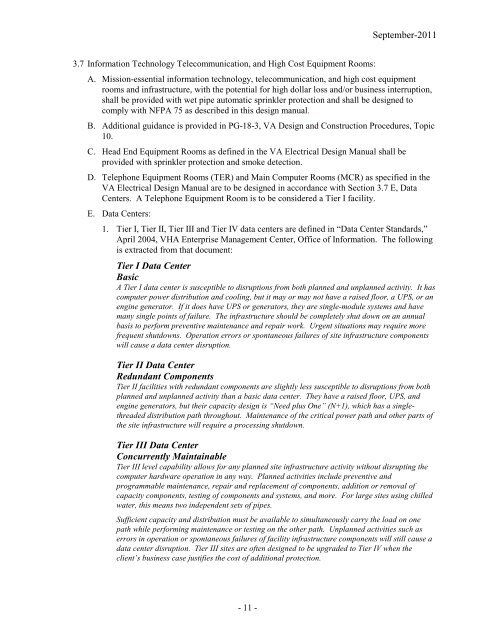Fire Protection Design Manual - Office of Construction and Facilities ...
Fire Protection Design Manual - Office of Construction and Facilities ...
Fire Protection Design Manual - Office of Construction and Facilities ...
Create successful ePaper yourself
Turn your PDF publications into a flip-book with our unique Google optimized e-Paper software.
September-2011<br />
3.7 Information Technology Telecommunication, <strong>and</strong> High Cost Equipment Rooms:<br />
A. Mission-essential information technology, telecommunication, <strong>and</strong> high cost equipment<br />
rooms <strong>and</strong> infrastructure, with the potential for high dollar loss <strong>and</strong>/or business interruption,<br />
shall be provided with wet pipe automatic sprinkler protection <strong>and</strong> shall be designed to<br />
comply with NFPA 75 as described in this design manual.<br />
B. Additional guidance is provided in PG-18-3, VA <strong>Design</strong> <strong>and</strong> <strong>Construction</strong> Procedures, Topic<br />
10.<br />
C. Head End Equipment Rooms as defined in the VA Electrical <strong>Design</strong> <strong>Manual</strong> shall be<br />
provided with sprinkler protection <strong>and</strong> smoke detection.<br />
D. Telephone Equipment Rooms (TER) <strong>and</strong> Main Computer Rooms (MCR) as specified in the<br />
VA Electrical <strong>Design</strong> <strong>Manual</strong> are to be designed in accordance with Section 3.7 E, Data<br />
Centers. A Telephone Equipment Room is to be considered a Tier I facility.<br />
E. Data Centers:<br />
1. Tier I, Tier II, Tier III <strong>and</strong> Tier IV data centers are defined in “Data Center St<strong>and</strong>ards,”<br />
April 2004, VHA Enterprise Management Center, <strong>Office</strong> <strong>of</strong> Information. The following<br />
is extracted from that document:<br />
Tier I Data Center<br />
Basic<br />
A Tier I data center is susceptible to disruptions from both planned <strong>and</strong> unplanned activity. It has<br />
computer power distribution <strong>and</strong> cooling, but it may or may not have a raised floor, a UPS, or an<br />
engine generator. If it does have UPS or generators, they are single-module systems <strong>and</strong> have<br />
many single points <strong>of</strong> failure. The infrastructure should be completely shut down on an annual<br />
basis to perform preventive maintenance <strong>and</strong> repair work. Urgent situations may require more<br />
frequent shutdowns. Operation errors or spontaneous failures <strong>of</strong> site infrastructure components<br />
will cause a data center disruption.<br />
Tier II Data Center<br />
Redundant Components<br />
Tier II facilities with redundant components are slightly less susceptible to disruptions from both<br />
planned <strong>and</strong> unplanned activity than a basic data center. They have a raised floor, UPS, <strong>and</strong><br />
engine generators, but their capacity design is “Need plus One” (N+1), which has a singlethreaded<br />
distribution path throughout. Maintenance <strong>of</strong> the critical power path <strong>and</strong> other parts <strong>of</strong><br />
the site infrastructure will require a processing shutdown.<br />
Tier III Data Center<br />
Concurrently Maintainable<br />
Tier III level capability allows for any planned site infrastructure activity without disrupting the<br />
computer hardware operation in any way. Planned activities include preventive <strong>and</strong><br />
programmable maintenance, repair <strong>and</strong> replacement <strong>of</strong> components, addition or removal <strong>of</strong><br />
capacity components, testing <strong>of</strong> components <strong>and</strong> systems, <strong>and</strong> more. For large sites using chilled<br />
water, this means two independent sets <strong>of</strong> pipes.<br />
Sufficient capacity <strong>and</strong> distribution must be available to simultaneously carry the load on one<br />
path while performing maintenance or testing on the other path. Unplanned activities such as<br />
errors in operation or spontaneous failures <strong>of</strong> facility infrastructure components will still cause a<br />
data center disruption. Tier III sites are <strong>of</strong>ten designed to be upgraded to Tier IV when the<br />
client’s business case justifies the cost <strong>of</strong> additional protection.<br />
- 11

















